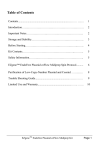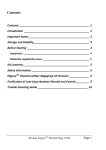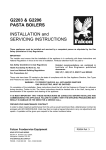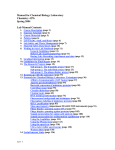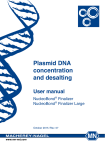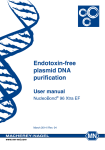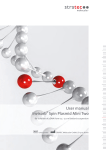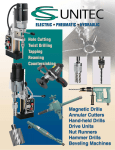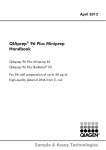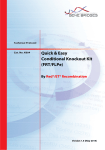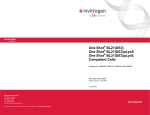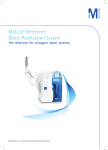Download EZNA® Endo-Free Plasmid DNA Midi Kit EZNA - Omega Bio-Tek
Transcript
E.Z.N.A.® Endo-Free Plasmid DNA Midi Kit D6915-00 D6915-01 D6915-03 D6915-04 2 preps 10 preps 25 preps 100 preps E.Z.N.A.® Endo-Free Plasmid DNA Maxi Kit D6926-00 D6926-01 D6926-03 D6926-04 2 preps 6 preps 25 preps 100 preps April 2013 E.Z.N.A.® Endo-Free Plasmid DNA Midi Kit E.Z.N.A.® Endo-Free Plasmid DNA Maxi Kit Table of Contents Introduction......................................................................................................2 Yield and Quality of DNA.............................................................................3 Illustrated Protocols........................................................................................4 Kit Contents.......................................................................................................5 Preparing Reagents / Storage and Stability...........................................6 Guidelines for Vacuum Manifold...............................................................7 Endo-Free Plasmid DNA Midi Vacuum Protocol........................10 Endo-Free Plasmid DNA Midi Centrifugation Protocol............15 Endo-Free Plasmid DNA Maxi Vacuum Protocol........................20 Endo-Free Plasmid DNA Maxi Centrifugation Protocol...........25 Modified Protocols........................................................................................30 Troubleshooting Guide...............................................................................33 Ordering...........................................................................................................35 Manual Revision: April 2013 Innovations in nucleic acid isolation 1 Introduction The E.Z.N.A.® Endo-Free Plasmid Midi Kit and the Endo-Free Plasmid Maxi Kit combine the power of HiBind® technology with Omega Bio-tek’s innovative Endotoxin Removal Technology (ETR) to deliver high-quality plasmid DNA with low endotoxin levels for use in eukaryotic transfection, and in vitro experiments. Endotoxins are lipopolysaccharides (LPS), found in the outer cell membrane of gram negative bacteria such as E. coli. One E. coli cell contains around 2 million LPS molecules, each having hydrophobic, hydrophilic, and charged regions. Bacteria release small quantities of endotoxins during growth, and large quantities at death. At the time of lysis during plasmid purification, endotoxins are shed into the lysate. The chemical and physical properties that endotoxin molecules possess lead to their co-purification with plasmid DNA by behaving similarly on the surface of silica and anion-exchange resins. The E.Z.N.A.® Endo-Free Plasmid System uses a specially formulated buffer that prevents endotoxin molecules from binding to the surface of the HiBind® matrix. In addition, the E.Z.N.A.® Endo-Free Plasmid Midi and Maxi Kits include specialized filter cartridges that replace the centrifugation step following alkaline lysis. For the best interpretation of results it is crucial that the purified plasmid DNA be free of endotoxins. Endotoxin contamination lowers transfection efficiencies for endotoxin sensitive cell lines. For gene therapy, endotoxin contamination should be of major concern since endotoxins have the potential to cause fever, endotoxic shock syndrome, and interfere with in vitro transfection into immune cells. New In this Edition: • • 2 Equilibration Buffer is no longer included with this kit. An optional Column Equilibration Protocol has been added to the protocol for your convenience. Equilibration Buffer is replaced with 3M NaOH provided by the user. Yield and Quality of DNA Determine the absorbance of an appropriate dilution (20 to 50 fold) of the sample at 260 nm and then at 280 nm. The DNA concentration is calculated as follows: DNA concentration = Absorbance 260 × 50 × (Dilution Factor) µg/mL A ratio greater than 1.8 indicates greater than 90% nucleic acid. Alternatively, quantity (as well as quality) can sometimes best be determined by agarose gel/ethidium bromide electrophoresis by comparison to DNA samples of known concentrations. Typically, the majority of the DNA eluted is in monomeric supercoil form, though concatamers may also be present. Plasmid Copy Number and Expected Yield The yield and quality of the plasmid DNA obtained depends on a number of factors including plasmid copy number, size of insert, host strain, culture volume, culture medium, and binding capacity of the kits. Of these factors, the vector copy number, culture volume, and kit binding capacity are most important. Plasmid copy number ranges from one copy to several hundred copies per cell as dictated by their origin of replication. But very large plasmids often display a very low copy number per cell. The expected yield of 50 mL overnight cultures (LB medium) with the E.Z.N.A.® Endo-Free Plasmid DNA Midi or Maxi Kit are indicated in the following table. Sample yields from 50 mL starting culture Replicon Copy Number Expected Yield (50 mL culture) pMBI 500-700 150-250 µg pBluescript® vectors ColE14 300-500 100-180 µg pGEM® vectors pMB1 300-400 100-200 µg pBR322 and its derivatives pMB1 15-20 10-20 µg ColE14 ColE14 15-20 10-20 µg PACYC and its derivatives p15A 37-40 5-10 µg pSC101 and its derivatives pSC101 ~5 5 µg pMB1 300-700 100-200 µg Plasmid pUC vectors pGEM 3 Centrifugation Protocol Vacuum Protocol Pellet by Centrifugation Pellet by Centrifugation Resuspend Lyse Neutralize Resuspend Lyse Neutralize Transfer Lysate to Syringe Transfer Lysate to Syringe Insert Plunger into Syringe and Clear Lysate into 15 mL Collection Tube Insert Plunger into Syringe and Clear Lysate into 15 mL Collection Tube Prepare Vacuum Manifold Add ETR Binding Buffer Add ETR Binding Buffer Add Equilibration Buffer Pass Lysate through HiBind® DNA Column Insert column into leur connector on vacuum manifold Add Equilibration Buffer Pass Lysate through HiBind® DNA Column Wash 4X Wash 4X 4 Dry HiBind® matrix Dry HiBind® matrix Elute Endotoxin-free DNA Elute Endotoxin-free DNA Kit Contents E.Z.N.A.® Endo-Free Plasmid DNA Midi Kit D6915-00 D6915-01 D6915-03 D6915-04 Purifications 2 10 25 100 HiBind® DNA Midi Columns 2 10 25 100 15 mL Collection Tubes 2 10 25 100 Lysate Clearance Filter Syringe 2 10 25 100 Solution I 6 mL 30 mL 80 mL 270 mL Solution II 6 mL 30 mL 80 mL 270 mL N3 Buffer 3 mL 15 mL 40 mL 140 mL ETR Binding Buffer 15 mL 60 mL 170 mL 650 mL ETR Wash Buffer 6 mL 30 mL 60 mL 230 mL EHB Buffer 7 mL 35 mL 85 mL 330 mL DNA Wash Buffer 4 mL 15 mL 40 mL 200 mL RNase A 20 µL 100 µL 300 µL 1.2 mL Endo-Free Elution Buffer 4 mL 20 mL 60 mL 200 mL P P P P D6926-00 D6926-01 D6926-03 D6926-04 Purifications 2 6 25 100 HiBind® DNA Maxi Columns 2 6 25 100 50 mL Collection Tubes 2 6 25 100 User Manual E.Z.N.A.® Endo-Free Plasmid DNA Maxi Kit Lysate Clearance Filter Syringe 2 6 25 100 Solution I 30 mL 70 mL 270 mL 1050 mL Solution II 30 mL 70 mL 270 mL 1050 mL N3 Buffer 15 mL 35 mL 135 mL 530 mL ETR Binding Buffer 55 mL 170 mL 650 mL 3 x 900 mL ETR Wash Buffer 25 mL 70 mL 270 mL 2 x 550 mL EHB Buffer 25 mL 70 mL 270 mL 1050 mL DNA Wash Buffer 15 mL 40 mL 150 mL 3 x 200 mL RNase A 120 µL 300 µL 1.2 mL 5 mL Endo-Free Elution Buffer 10 mL 40 mL 90 mL 2 x 160 mL P P P P User Manual 5 Preparing Reagents 1. Add vial of RNase A to the bottle of Solution I provided and store at 2-8˚C. 2. Dilute DNA Wash Buffer with 100% ethanol as follows and store at room temperature. Kit 100% Ethanol to be Added D6915-00 16 mL D6915-01 60 mL D6915-03 160 mL D6915-04 800 mL Kit 3. 100% Ethanol to be Added D6926-00 60 mL D6926-01 160 mL D6926-03 600 mL D6926-04 800 mL per bottle Check Solution II, EHB Buffer, and ETR Binding Buffer for precipitates before use. Redissolve any precipitates by warming to 37˚C. Storage and Stability All of the E.Z.N.A.® Endo-Free Plasmid DNA Midi and Maxi Kit components are guaranteed for at least 12 months from the date of purchase when stored as follows. After RNase A is added, Solution I should be stored at 2-8˚C. All other components should be stored at room temperature. Store Solution II tightly capped when not in use. During shipment or storage in cool ambient conditions, precipitates may form in EHB Buffer, Solution II, and ETR Binding Buffer. Dissolve such deposits by warming the solution at 37°C and gently shaking. 6 Guidelines for Vacuum Manifold The following is required for use with the Vacuum/Spin Protocol: A) Vacuum Manifold (We recommend Omega Bio-tek’s VAC-08) Other Compatible Vacuum Manifolds: Qiagen QIAvac24, Sigma AldrichVM20, Promega Vacman®, or manifold with standard Luer connector B) Vacuum Flask C) Vacuum Tubing D) Vacuum Source (review tables below for pressure settings) Manifold VAC-08 Conversion from millibars: Recommended Pressure (mbar) -200 to -600 Multiply by: Millimeters of mercury (mmHg) 0.75 Kilopascals (kPa) 0.1 Inches of mercury (inch Hg) 0.0295 Torrs (Torr) Atmospheres (atmos) Pounds per Square Inch (psi) 0.75 0.000987 0.0145 Vacuum Setup: Omega Bio-tek’s VAC-08 C) Vacuum Tubing D) Vacuum Source A) Vacuum Manifold B) Vacuum Flask 7 Recommended Settings Growth and Culture of Bacteria Bacterial Strain Selection It is strongly recommended that an end A negative strain of E. coli be used for routine plasmid isolation. Examples of such strains include DH5α™ , DH1, and C600. These host strains yield high-quality DNA with E.Z.N.A.® Endo-Free Plasmid DNA Kit Protocols. XL1Blue, although a slower growing strain is also recommended due to its yield of highquality DNA. Host strains derivatives from HB101 such as TG1 and the JM100 series release large amounts of carbohydrates during lysis, which may inhibit enzyme activity when not completely removed. Some strains may also lower DNA quality due to having high levels of endonuclease activity, and therefore are not recommended (i.e. JM101, JM110, HB101). One may reduce the amount of culture volume or double the volumes of Solution I, Solution II, and N3 Buffer, if problems are encountered with strains such as TG1 and Top10F. Inoculation Bacterial cultures for plasmid preparations should always be grown from a single colony picked from a freshly streaked plate. Subculturing directly from glycerol stock or liquid cultures may lead to uneven yields or plasmid loss. Optimal results are obtained by using one single isolated colony from a freshly transformed or freshly streaked plate to inoculate an appropriate volume of starter culture containing the appropriate antibiotic, and then incubated for 12-16 at 37°C with vigorous shaking (~300 rpm; shaking incubator). Note: Aeration is very important. The culture volume should not exceed 1/4 the volume of the container. Culture Media The E.Z.N.A.® Endo-Free Plasmid DNA Kits are specially designed for use with cultures grown in Luria Bertani (LB) medium. Richer broths such as TB(Terrific Broth) or 2 x YT lead to high cell densities that can overload the purification system, and therefore are not recommended. If rich media has to be used, growth times have to be optimized, and the recommended culture volumes must be reduced to match the capacity of the HiBind® DNA Column. Note: As culture ages, DNA yield may begin to decrease due to cell death and lysis within the culture. 8 Recommended Settings Culture Volume and Cell Density Do Not Exceed Maximum Recommended Culture Volumes For optimal plasmid yields, the starting culture volume should be based on culture cell density. A bacterial density between 2.0 and 3.0 at OD600 is recommended. When using nutrient-rich media, care should be taken to ensure that the cell density does not exceed an OD600 of 3.0. Using a high-density culture outside of the recommended OD range may overload the purification system. 9 Endo-Free Plasmid DNA Midi Kit Vacuum Protocol E.Z.N.A.® Endo-Free Plasmid DNA Midi Kit - Vacuum Protocol All centrifugation steps should be performed with a swing bucket rotor for maximum plasmid DNA yields. All centrifugation steps should be carried out at room temperature. If high yields of low copy number plasmid DNA are desired, see “Low Copy Number Plasmids and Cosmids” protocol on Page 31. Materials and Equipment to be Supplied by User: • • • • • • • • 100% Ethanol (Do not use denatured alcohol) Centrifuge with swing bucket rotor capable of at least 4,000 x g (See the “Troubleshooting” section on Page 34 if not available) Nuclease-free 15 mL and 50 mL centrifuge tubes Vacuum manifold Vortexer Ice bucket Optional: Water bath or incubator capable of 70°C Optional: 3M NaOH Before starting: • • • Chill N3 Buffer on ice Heat Elution Buffer to 70°C if Plasmid DNA is >10 kb Prepare DNA Wash Buffer and Solution 1 according to “Preparing Reagents” section on Page 6 1. Transfer 20-50 mL overnight culture to a 50 mL centrifuge tube (not provided). Note: The optimal volume to use depends on the culture density and plasmid copy number. The optimal cell mass (OD600 x mL culture) for the HiBind® DNA Midi Column is 80-100. For example, if the OD600 of a culture is 4.0, the optimal culture volume should be 20-25 mL. If excess culture cell mass is used, alkaline lysis will be inefficient, the HiBind® membrane will be overloaded, and the performance of the system will be decreased. The increase in lysate viscosity will require vigorous mixing which may result in shearing of genomic DNA and contamination the plasmid DNA. For low copy number plasmids, see the “Low Copy Number Plasmids” protocol on Page 31. 2. 10 Centrifuge at 4,000 x g for 10 minutes at room temperature. Endo-Free Plasmid DNA Midi Kit Vacuum Protocol 3. Decant or aspirate and discard the culture media. Note: To ensure that all traces of the medium are removed, use a clean paper towel to blot excess liquid from the wall of the tube. 4. Add 2.5 mL Solution I/RNase A. Vortex or pipet up and down to completely resuspend the cells. Note: RNase A must be added to Solution I before use. Please see the instructions in the “Preparing Reagents” section on Page 6. 5. Add 2.5 mL Solution II. Invert and rotate the tube gently 8-10 times to obtain a cleared lysate. This may require a 2-3 minute incubation at room temperature with occasional mixing. Note: Avoid vigorous mixing as this will shear chromosomal DNA and lower plasmid purity. Do not allow the lysis reaction to proceed more than 5 minutes. Store Solution II tightly capped when not in use to avoid acidification from CO2 in the air. 6. Add 1.25 mL cold N3 Buffer. Gently invert 10 times or until a flocculent white precipitate forms. This may require a 2 minute incubation at room temperature with occasional mixing. Note: The solution must be mixed thoroughly. This is vital for obtaining good yields. If the mixture still appears viscous, brownish, or conglobated, more mixing is required to completely neutralize the solution. 7. Prepare a Lysate Clearance Filter Syringe by removing the plunger. Place the barrel in a tube rack to keep upright. Make sure the end cap is attached to the syringe tip. 8. Immediately transfer the lysate from Step 6 into the barrel of the Lysate Clearance Filter Syringe. 9. Hold the Lysate Clearance Filter Syringe barrel over a clean 15 mL centrifuge tube (not provided) and remove the end cap from the syringe tip. 11 Endo-Free Plasmid DNA Midi Kit Vacuum Protocol 10. Gently insert the plunger into the barrel to expel the cleared lysate into the 15 mL centrifuge tube. Note: Some of the lysate may remain in the flocculent precipitate. DO NOT force this residual lysate through the filter. 11. Measure the volume of cleared lysate. 12. Add 1 volume ETR Binding Buffer. Invert the tube gently 10 times. 13. Prepare the vacuum manifold by following the manufacturer’s instructions. 14. Connect the HiBind® DNA Midi Column to the vacuum manifold. Refer to the Illustrated Vacuum Set Up on Page 7 for details. Optional Protocol for Column Equilibration: 1. 2. 3. Add 1 mL 3M NaOH to the HiBind® DNA Midi Column. Turn on the vacuum source to draw the buffer through the column. Turn off the vacuum. 15. Transfer the cleared lysate from Step 13 to the HiBind® DNA Midi Column. 16. Turn on the vacuum source to draw the lysate through the column. 17. Continue adding lysate into until you have ~500 µL lysate remaining in the column. Note: Leaving the ~500 µL lysate in the column prevents foaming in the following steps and allows for faster processing. See the illustration below. Leaving 500 µL solution in the column after Step 21 reduces foam which decreases total processing time and improves efficiency. 12 Endo-Free Plasmid DNA Midi Kit Vacuum Protocol 18. Turn off the vacuum. 19. Add 2 mL ETR Wash Buffer. 20. Turn on the vacuum source to draw the buffer through the column. 21. Turn off the vacuum. 22. Add 3 mL EHB Buffer. 23. Turn on the vacuum source to draw the buffer through the column. 24. Turn off the vacuum. 25. Add 3.5 mL DNA Wash Buffer. Note: DNA Wash Buffer must be diluted with 100% ethanol prior to use. Please see the instructions in the “Preparing Reagents” section on Page 6. 26. Turn on the vacuum source to draw the buffer through the column. 27. Turn off the vacuum. 28. Repeat Steps 25-27 for a second DNA Wash Buffer wash step. 29. Transfer the HiBind® DNA Midi Column to a 15 mL Collection Tube (provided). 30. Centrifuge the empty HiBind® DNA Midi Column at 4,000 x g for 10 minutes to dry the column matrix. Note: It is important to dry the HiBind® DNA Midi Column matrix before elution. Residual ethanol may interfere with downstream applications. 13 Endo-Free Plasmid DNA Midi Kit Vacuum Protocol 31. Transfer the HiBind® DNA Midi Column to a nuclease-free 15 mL centrifuge tube. 32. Add 0.5-1 mL Endo-Free Elution Buffer directly to the center of the column matrix. 33. Let it sit at room temperature for 3 minutes. 34. Centrifuge at 4,000 x g for 5 minutes. Note: This represents approximately 65-80% of bound DNA. An optional second elution will yield any residual DNA, though at a lower concentration. Alternatively, a second elution may be performed using the first eluate to maintain a high DNA concentration. 35. Store DNA at -20°C. 14 Endo-Free Plasmid DNA Midi Kit Centrifugation Protocol E.Z.N.A.® Endo-Free Plasmid DNA Midi Kit - Centrifugation Protocol The following protocol is designed for plasmid DNA isolation when a vacuum manifold is not available. All centrifugation steps should be performed with a swing bucket rotor for maximum plasmid DNA yields. All centrifugation steps should be carried out at room temperature. If high yields of low copy number plasmid DNA are desired, see “Low Copy Number Plasmids and Cosmids” protocol on Page 31. Materials and Equipment to be Supplied by User: • • • • • • • 100% Ethanol (Do not use denatured alcohol) Centrifuge with swing bucket rotor capable of at least 4,000 x g (See the “Troubleshooting” section on Page 34 if not available) Nuclease-free 15 mL and 50 mL centrifuge tubes Vortexer Ice bucket Optional: Water bath or incubator capable of 70°C Optional: 3M NaOH Before starting: • • • Chill N3 Buffer on ice Heat Elution Buffer to 70°C if Plasmid DNA is >10 kb Prepare DNA Wash Buffer and Solution 1 according to “Preparing Reagents” section on Page 6 1. Transfer 20-50 mL overnight culture to a 50 mL centrifuge tube (not provided). Note: The optimal volume to use depends on the culture density and plasmid copy number. The optimal cell mass (OD600 x mL culture) for the HiBind® DNA Midi Column is 80-100. For example, if the OD600 of a culture is 4.0, the optimal culture volume should be 20-25 mL. If excess culture cell mass is used, alkaline lysis will be inefficient, the HiBind® membrane will be overloaded, and the performance of the system will be decreased. The increase in lysate viscosity will require vigorous mixing which may result in shearing of genomic DNA and contamination the plasmid DNA. For low copy number plasmids, see the “Low Copy Number Plasmids” protocol on Page 31. 2. Centrifuge at 4,000 x g for 10 minutes at room temperature. 15 Endo-Free Plasmid DNA Midi Kit Centrifugation Protocol 3. Decant or aspirate and discard the culture media. Note: To ensure that all traces of the medium are removed, use a clean paper towel to blot excess liquid from the wall of the tube. 4. Add 2.5 mL Solution I/RNase A. Vortex or pipet up and down to completely resuspend the cells. Note: RNase A must be added to Solution I before use. Please see the instructions in the “Preparing Reagents” section on Page 6. 5. Add 2.5 mL Solution II. Invert and rotate the tube gently 8-10 times to obtain a cleared lysate. This may require a 2-3 minute incubation at room temperature with occasional mixing. Note: Avoid vigorous mixing as this will shear chromosomal DNA and lower plasmid purity. Do not allow the lysis reaction to proceed more than 5 minutes. Store Solution II tightly capped when not in use to avoid acidification from CO2 in the air. 6. Add 1.25 mL cold N3 Buffer. Gently invert 10 times or until a flocculent white precipitate forms. This may require a 2 minute incubation at room temperature with occasional mixing. Note: The solution must be mixed thoroughly. This is vital for obtaining good yields. If the mixture still appears viscous, brownish, or conglobated, more mixing is required to completely neutralize the solution. 7. Prepare a Lysate Clearance Filter Syringe by removing the plunger. Place the barrel in a tube rack to keep upright. Make sure the end cap is attached to the syringe tip. 8. Immediately transfer the lysate from Step 6 into the barrel of the Lysate Clearance Filter Syringe. 9. Hold the Lysate Clearance Filter Syringe barrel over a clean 15 mL centrifuge tube (not provided) and remove the end cap from the syringe tip. 16 Endo-Free Plasmid DNA Midi Kit Centrifugation Protocol 10. Gently insert the plunger into the barrel to expel the cleared lysate into the 15 mL centrifuge tube. Note: Some of the lysate may remain in the flocculent precipitate. DO NOT force this residual lysate through the filter. 11. Measure the volume of cleared lysate. 12. Add 1 volume ETR Binding Buffer. Invert the tube gently 10 times. Note: Steps 13-32 should be performed in a swing bucket rotor for maximum plasmid DNA yield. All of centrifugation steps should be carried out at room temperature. 13. Insert a HiBind® DNA Midi Column into a 15 mL Collection Tube (provided). Optional Protocol for Column Equilibration: 1. 2. 3. 4. Add 1 mL 3M NaOH to the HiBind® DNA Midi Column. Let sit at room temperature for 4 minutes. Centrifuge at 4,000 x g for 3 minutes. Discard the filtrate and reuse the collection tube. 14. Transfer 3.5 mL cleared supernatant from Step 12 to the HiBind® DNA Midi Column. 15. Centrifuge at 4,000 x g for 3 minutes. 16. Discard the filtrate and reuse the collection tube. 17. Repeat Steps 14-16 until all of the cleared supernatant has been transferred to the HiBind® DNA Midi Column. 18. Add 2 mL ETR Wash Buffer. 17 Endo-Free Plasmid DNA Midi Kit Centrifugation Protocol 19. Centrifuge at 4,000 x g for 3 minutes. 20. Discard the filtrate and reuse the collection tube. 21. Add 3 mL EHB Buffer. 22. Centrifuge at 4,000 x g for 3 minutes. 23. Discard the filtrate and reuse the collection tube. 24. Add 3.5 mL DNA Wash Buffer. Note: DNA Wash Buffer must be diluted with 100% ethanol prior to use. Please see the instructions in the “Preparing Reagents” section on Page 6. 25. Centrifuge at 4,000 x g for 3 minutes. 26. Discard the filtrate and reuse the collection tube. 27. Repeat Steps 24-26 for a second DNA Wash Buffer wash step. 28. Centrifuge the empty HiBind® DNA Midi Column at 4,000 x g for 10 minutes to dry the column matrix. Note: It is important to dry the HiBind® DNA Midi Column matrix before elution. Residual ethanol may interfere with downstream applications. 29. Transfer the HiBind® DNA Midi Column to a nuclease-free 15 mL centrifuge tube. 18 Endo-Free Plasmid DNA Midi Kit Centrifugation Protocol 30. Add 0.5-1 mL Endo-Free Elution Buffer directly to the center of the column matrix. 31. Let it sit at room temperature for 3 minutes. 32. Centrifuge at 4,000 x g for 5 minutes. Note: This represents approximately 65-80% of bound DNA. An optional second elution will yield any residual DNA, though at a lower concentration. Alternatively, a second elution may be performed using the first eluate to maintain a high DNA concentration. 33. Store DNA at -20°C. 19 Endo-Free Plasmid DNA Maxi Kit Vacuum Protocol E.Z.N.A.® Endo-Free Plasmid DNA Maxi Kit - Vacuum Protocol All centrifugation steps should be performed with a swing bucket rotor for maximum plasmid DNA yields. All centrifugation steps should be carried out at room temperature. If high yields of low copy number plasmid DNA are desired, see “Low Copy Number Plasmids and Cosmids” protocol on Page 31. Materials and Equipment to be Supplied by User: • • • • • • • • • 100% Ethanol (Do not use denatured alcohol) Centrifuge with swing bucket rotor capable of at least 4,000 x g (See the “Troubleshooting” section on Page 27 if not available) Vacuum manifold Vortexer Nuclease-free 50 mL centrifuge tubes Appropriate centrifuge bottle for Step 1 Ice bucket Optional: Water bath or incubator capable of 70°C Optional: 3M NaOH Before starting: • • • Chill N3 Buffer on ice Heat Elution Buffer to 70°C if Plasmid DNA is >10 kb Prepare DNA Wash Buffer and Solution 1 according to “Preparing Reagents” section on Page 6 1. Transfer 50-200 mL overnight culture to an appropriate centrifuge bottle (not provided). Note: The optimal volume to use depends on the culture density and plasmid copy number. The optimal cell mass (OD600 x mL culture) for the HiBind® DNA Maxi Column is 300-400. For example, if the OD600 of a culture is 4.0, the optimal culture volume should be 75-100 mL. If excess culture cell mass is used, alkaline lysis will be inefficient, the HiBind® membrane will be overloaded, and the performance of the system will be decreased. The increase in lysate viscosity will require vigorous mixing which may result in shearing of genomic DNA and contamination the plasmid DNA. For low copy number plasmids, see the “Low Copy Number Plasmids” protocol on Page 31. 20 Endo-Free Plasmid DNA Maxi Kit Vacuum Protocol 2. 3. Centrifuge at 4,000 x g for 10 minutes at room temperature. Decant or aspirate and discard the culture media. Note: To ensure that all traces of the medium are removed, use a clean paper towel to blot excess liquid from the wall of the bottle. 4. Add 10 mL Solution I/RNase A. Vortex or pipet up and down to mix thoroughly. Complete resuspension of cell pellet is vital for obtaining good yields. Note: RNase A must be added to Solution I before use. Please see the instructions in the “Preparing Reagents” section on Page 6. 5. Add 10 mL Solution II. Invert and rotate the tube gently 8-10 times to obtain a cleared lysate. This may require a 2-3 minute incubation at room temperature with occasional mixing. Note: Avoid vigorous mixing as this will shear chromosomal DNA and lower plasmid purity. Do not allow the lysis reaction to proceed more than 5 minutes. Store Solution II tightly capped when not in use to avoid acidification from CO2 in the air. 6. Add 5 mL cold N3 Buffer. Gently invert 10 times or until a flocculent white precipitate forms. This may require a 2 minute incubation at room temperature with occasional mixing. Note: The solution must be mixed thoroughly. This is vital for obtaining good yields. If the mixture still appears viscous, brownish, or conglobated, more mixing is required to completely neutralize the solution. 7. Prepare a Lysate Clearance Filter Syringe by removing the plunger. Place the barrel in a tube rack to keep upright. Make sure the end cap is attached to the syringe tip. 8. Immediately transfer the lysate from Step 6 into the barrel of the Lysate Clearance Filter Syringe. 9. Hold the Lysate Clearance Filter Syringe barrel over a new 50 mL centrifuge tube (not 21 Endo-Free Plasmid DNA Maxi Kit Vacuum Protocol provided) and remove the end cap from the syringe tip. 10. Gently insert the plunger into the barrel to expel the cleared lysate into the 50 mL centrifuge tube. Note: Some of the lysate may remain in the flocculent precipitate. DO NOT force this residual lysate through the filter. 11. Measure the volume of cleared lysate. 12. Add 1 volume ETR Binding Buffer. Invert the tube gently 10 times. 13. Prepare the vacuum manifold by following the manufacturer’s instructions. 14. Connect the HiBind® DNA Maxi Column to the vacuum manifold. Refer to the Illustrated Vacuum Set Up on Page 7 for details. Optional Protocol for Column Equilibration: 1. 2. 3. 4. Add 3 mL 3M NaOH to the HiBind® DNA Midi Column. Let sit at room temperature for 5 minutes. Turn on the vacuum source to draw the buffer through the column. Turn off the vacuum. 15. Transfer the cleared lysate from Step 12 to the HiBind® DNA Maxi Column. 16. Turn on the vacuum source to draw the lysate through the column. 17. Continue adding lysate into until you have ~500 µL lysate remaining in the column. Note: Leaving the ~500 µL lysate in the column prevents foaming in the following steps and allows for faster processing. See the illustration below. Leaving 500 µL solution in the column after Step 21 reduces foam which decreases total processing time and improves efficiency. 22 Endo-Free Plasmid DNA Maxi Kit Vacuum Protocol 18. Turn off the vacuum. 19. Add 10 mL ETR Wash Buffer. 20. Turn on the vacuum source to draw the buffer through the column. 21. Turn off the vacuum. 22. Add 10 mL EHB Buffer. 23. Turn on the vacuum source to draw the buffer through the column. 24. Turn off the vacuum. 25. Add 15 mL DNA Wash Buffer. Note: DNA Wash Buffer must be diluted with 100% ethanol prior to use. Please see the instructions in the “Preparing Reagents” section on Page 6. 26. Turn on the vacuum source to draw the buffer through the column. 27. Turn off the vacuum. 28. Add 10 mL DNA Wash Buffer. 29. Turn on the vacuum source to draw the buffer through the column. 30. Turn off the vacuum. 31. Transfer the HiBind® DNA Maxi Column to a 50 mL Collection Tube (provided). 23 Endo-Free Plasmid DNA Maxi Kit Vacuum Protocol 32. Centrifuge the empty HiBind® DNA Maxi Column at 4,000 x g for 10 minutes to dry the column matrix. Note: It is important to dry the HiBind® DNA Maxi Column matrix before elution. Residual ethanol may interfere with downstream applications. 33. Transfer the HiBind® DNA Maxi Column to a nuclease-free 50 mL centrifuge tube. 34. Add 1.5-3 mL Endo-Free Elution Buffer directly to the center of the column matrix. 35. Let it sit at room temperature for 5 minutes. 36. Centrifuge at 4,000 x g for 5 minutes. Note: This represents approximately 65-80% of bound DNA. An optional second elution will yield any residual DNA, though at a lower concentration. Alternatively, a second elution may be performed using the first eluate to maintain a high DNA concentration. 37. Store DNA at -20°C. 24 Endo-Free Plasmid DNA Maxi Kit Centrifugation Protocol E.Z.N.A.® Endo-Free Plasmid DNA Maxi Kit - Centrifugation Protocol The following protocol is designed for plasmid DNA isolation when a vacuum manifold is not available. All centrifugation steps should be performed with a swing bucket rotor for maximum plasmid DNA yields. All centrifugation steps should be carried out at room temperature. If high yields of low copy number plasmid DNA are desired, see “Low Copy Number Plasmids and Cosmids” protocol on Page 31. Materials and Equipment to be Supplied by User: • • • • • • • • 100% Ethanol (Do not use denatured alcohol) Centrifuge with swing bucket rotor capable of at least 4,000 x g (See the “Troubleshooting” section on Page 27 if not available) Vortexer Nuclease-free 50 mL centrifuge tubes Appropriate centrifuge bottle for Step 1 Ice bucket Optional: Water bath or incubator capable of 70°C Optional: 3M NaOH Before starting: • • • Chill N3 Buffer on ice Heat Elution Buffer to 70°C if Plasmid DNA is >10 kb Prepare DNA Wash Buffer and Solution 1 according to “Preparing Reagents” section on Page 6 1. Transfer 50-200 mL overnight culture to an appropriate centrifuge bottle. Note: The optimal volume to use depends on the culture density and plasmid copy number. The optimal cell mass (OD600 x mL culture) for the HiBind® DNA Maxi Column is 300-400. For example, if the OD600 of a culture is 4.0, the optimal culture volume should be 75-100 mL. If excess culture cell mass is used, alkaline lysis will be inefficient, the HiBind® membrane will be overloaded, and the performance of the system will be decreased. The increase in lysate viscosity will require vigorous mixing which may result in shearing of genomic DNA and contamination the plasmid DNA. For low copy number plasmids, see the “Low Copy Number Plasmids” protocol on Page 31. 25 Endo-Free Plasmid DNA Maxi Kit Centrifugation Protocol 2. 3. Centrifuge at 4,000 x g for 10 minutes at room temperature. Decant or aspirate and discard the culture media. Note: To ensure that all traces of the medium are removed, use a clean paper towel to blot excess liquid from the wall of the bottle. 4. Add 10 mL Solution I/RNase A. Vortex or pipet up and down to mix thoroughly. Complete resuspension of cell pellet is vital for obtaining good yields. Note: RNase A must be added to Solution I before use. Please see the instructions in the “Preparing Reagents” section on Page 6. 5. Add 10 mL Solution II. Invert and rotate the tube gently 8-10 times to obtain a cleared lysate. This may require a 2-3 minute incubation at room temperature with occasional mixing. Note: Avoid vigorous mixing as this will shear chromosomal DNA and lower plasmid purity. Do not allow the lysis reaction to proceed more than 5 minutes. Store Solution II tightly capped when not in use to avoid acidification from CO2 in the air. 6. Add 5 mL cold N3 Buffer. Gently invert 10 times or until a flocculent white precipitate forms. This may require a 2 minute incubation at room temperature with occasional mixing. Note: The solution must be mixed thoroughly. This is vital for obtaining good yields. If the mixture still appears viscous, brownish, or conglobated, more mixing is required to completely neutralize the solution. 7. Prepare a Lysate Clearance Filter Syringe by removing the plunger. Place the barrel in a tube rack to keep upright. Make sure the end cap is attached to the syringe tip. 8. Immediately transfer the lysate from Step 6 into the barrel of the Lysate Clearance Filter Syringe. 9. Hold the Lysate Clearance Filter Syringe barrel over a new 50 mL centrifuge tube (not 26 Endo-Free Plasmid DNA Maxi Kit Centrifugation Protocol provided) and remove the end cap from the syringe tip. 10. Gently insert the plunger into the barrel to expel the cleared lysate into the 50 mL centrifuge tube. Note: Some of the lysate may remain in the flocculent precipitate. DO NOT force this residual lysate through the filter. 11. Measure the volume of cleared lysate. 12. Add 1 volume ETR Binding Buffer. Invert the tube gently 10 times. Note: Steps 13-35 should be performed in a swing bucket rotor for maximum plasmid DNA yield. All of centrifugation steps should be carried out at room temperature. 13. Insert a HiBind® DNA Maxi Column into a 50 mL Collection Tube (provided). Optional Protocol for Column Equilibration: 1. 2. 3. 4. Add 3 mL 3M NaOH to the HiBind® DNA Maxi Column. Let sit at room temperature for 4 minutes. Centrifuge at 4,000 x g for 3 minutes. Discard the filtrate and reuse the collection tube. 14. Transfer 20 mL cleared supernatant from Step 12 to the HiBind® DNA Maxi Column. 15. Centrifuge at 4,000 x g for 3 minutes. 16. Discard the filtrate and reuse the collection tube. 17. Repeat Steps 14-16 until all of the cleared supernatant has been transferred to the HiBind® DNA Maxi Column. 27 Endo-Free Plasmid DNA Maxi Kit Centrifugation Protocol 18. Add 10 mL ETR Wash Buffer. 19. Centrifuge at 4,000 x g for 3 minutes. 20. Discard the filtrate and reuse the collection tube. 21. Add 10 mL EHB Buffer. 22. Centrifuge at 4,000 x g for 3 minutes. 23. Discard the filtrate and reuse the collection tube. 24. Add 15 mL DNA Wash Buffer. Note: DNA Wash Buffer must be diluted with 100% ethanol prior to use. Please see the instructions in the “Preparing Reagents” section on Page 6. 25. Centrifuge at 4,000 x g for 3 minutes. 26. Discard the filtrate and reuse the collection tube. 27. Add 10 mL DNA Wash Buffer. 28. Centrifuge at 4,000 x g for 3 minutes. 29. Discard the filtrate and reuse the collection tube. 30. Centrifuge the empty HiBind® DNA Maxi Column at 4,000 x g for 10 minutes to dry the column matrix. Note: It is important to dry the HiBind® DNA Maxi Column matrix before elution. Residual ethanol may interfere with downstream applications. 28 Endo-Free Plasmid DNA Maxi Kit Centrifugation Protocol 31. Transfer the HiBind® DNA Maxi Column to a nuclease-free 50 mL centrifuge tube. 32. Add 1.5-3 mL Endo-Free Elution Buffer directly to the center of the column matrix. 33. Let it sit at room temperature for 5 minutes. 34. Centrifuge at 4,000 x g for 5 minutes. Note: This represents approximately 65-80% of bound DNA. An optional second elution will yield any residual DNA, though at a lower concentration. Alternatively, a second elution may be performed using the first eluate to maintain a high DNA concentration. 35. Store DNA at -20°C. 29 DNA Precipitation The concentration of the eluted plasmid DNA varies with copy number, host strain, and growth conditions. In some cases, residual ethanol may also be present. To adjust the DNA concentration following plasmid DNA elution or for the removal of residual ethanol, perform the following isopropanol precipitation protocol. 1. Carefully transfer the eluted plasmid DNA to a clean tube suitable for precipitation. Add 1/10 volume 3M NaAC (pH 5.2) and 0.7 volume isopropanol (room temperature). Vortex to mix. 2. Centrifuge at ≥15,000 x g for 20 minutes at 4ºC. 3. Carefully decant the supernatant. 4. Add 1-2 mL 70% ethanol. Vortex to resuspend the pellet. 5. Centrifuge at ≥15,000 x g for 10 minutes at 4ºC. 6. Carefully decant the supernatant. 7. Air dry the pellet for 10 minutes. 8. Add 200-500 µL Elution Buffer. 9. Store DNA at -20°C. 30 Low Copy Number Plasmid and Cosmid DNA Purification E.Z.N.A.® Endo-Free Plasmid DNA Midi/Maxi Kit Protocol - Low Copy Number Plasmid and Cosmid DNA Protocol Low copy number plasmids generally give 0.1-1 µg DNA per mL overnight culture. For the isolation of plasmid DNA from low copy number plasmids (0.1-1 µg/mL culture) or low copy number plasmid (1-2 µg/mL culture) bacteria, use the following modified protocol. Note: The E.Z.N.A.® Endo-Free Plasmid DNA Midi Kit and the E.Z.N.A.® Endo-Free Plasmid DNA Maxi Kit come with enough buffers to perform the standard protocols. Additional buffers are needed to perform the Low Copy Number Plasmid and Cosmid DNA Protocol. These buffers can be purchased separately. See Page 35 for ordering information. 1. Increase the volume of starting culture from that of high copy number plasmids. Use 50-100 mL bacterial culture for the E.Z.N.A.® Endo-Free Plasmid DNA Midi Kit and 200-400 mL bacterial culture for the E.Z.N.A.® Endo-Free Plasmid DNA Maxi Kit. 2. Pellet the bacterial cells by centrifugation. 3. Decant or aspirate and discard the culture media. 4. Perform Steps 4-12 in the standard protocols with double volumes of Solution I, Solution II, N3 Buffer, and ETR Binding Buffer. 5. Continue with Step 13 of the standard protocols by following the wash, drying, and elution steps. There is no need to increase the volumes of EHB Buffer, ETR Wash Buffer, DNA Wash Buffer, or Endo-Free Elution Buffer. 31 Purification of Plasmid DNA prepared by other Methods E.Z.N.A.® Endo-Free Plasmid DNA Midi/Maxi Kit Protocol Plasmid DNA Purification Plasmid DNA isolated using other methods can be further purified with the following protocol. The protocol includes the removal of endotoxins from the sample. 1. Bring the volume of plasmid DNA to 2 mL with sterile deionized water. 2. Add an equal volume ETR Binding Buffer. Vortex to mix thoroughly. 3. Transfer the sample to the HiBind® DNA Column. Draw the sample through the membrane by centrifugation or vacuum. 4. Continue the appropriate protocol beginning with the DNA Wash Buffer step and finishing with the elution step. 32 Troubleshooting Guide Please use this guide to troubleshoot any problems that may arise. For further assistance, please contact the technical support staff , toll free, at 1-800-832-8896. Possible Problems and Suggestions Low DNA Yields • • Poor cell lysis • Bacterial culture is overgrown or not fresh Low elution efficiency Low copy number plasmid used Columns were spun in a fixed angle rotor or with insufficient g-force Alkaline lysis is prolonged Too many or too few cells were used Reduce the initial volume of culture or increase the lysis time while monitoring the lysis visually. Cells may not have been dispersed adequately prior to the addition of Solution II. Make sure to vortex cell suspension to completely disperse. Solution II, if not tightly closed, may need to be replaced. • • Do not incubate cultures for more than 16 hours at 37ºC. Storage of cultures for extended periods prior to plasmid isolation is detrimental. • If using endotoxin-free water for elution, the pH must be 8.0 • Such plasmids may yield as little as 0.1 μg plasmid DNA from a 1 mL overnight culture. Double culture volume and follow the Low Copy Number Plasmid and Cosmid DNA Protocol. • • For the Midi and Maxi kits, the columns must be spun in a swing bucket rotor at 4,000 x g for liquids to pass through efficiently. • Reduce the lysis time (Solution II) to 3 minutes or until the suspended cells form a clear viscous solution. • Confirm the cell density by measuring OD. To calculate the volume of culture to use, take the desired cell mass and divide by the absorbance of the overnight culture at 600 nm. No DNA Eluted DNA Wash Buffer not diluted with ethanol • Prepare DNA Wash Buffer according to the instructions on Page 6. High molecular weight DNA contamination of product Over mixing of cell lysate upon addition of Solution II Culture overgrown • Do not vortex or mix aggressively after adding Solution II. • Overgrown culture contain lysed cells and degraded DNA. Do not grow cell longer than 16 hours. 33 Troubleshooting Guide Plasmid DNA floats out of well while loading agarose gel Ethanol has not been removed completely from column following wash steps • • Centrifuge column as instructed to dry the column before elution. Incubate columns for 10 minutes at 65°C to completely dry membrane after centrifugation step. Absorbance of purified DNA does not accurately reflect quality of the plasmid (A260/A280 ratio is too high or too low) DNA Wash Buffer is diluted with ethanol containing impurities Plasmid DNA is contaminated with RNA; RNase A treatment is insufficient. Background reading is high due to fine silica particulates Purification is incomplete due to column overloading Plasmid DNA is contaminated with chromosomal DNA • • • • Check the absorbance of the ethanol between 250 nm and 300 nm. Do not use ethanol with high absorbance. Trace impurities may remain on the column after washing and can contribute to the absorbance. Confirm that the RNase A was added to Solution I prior to first use. The RNase A Solution may degrade due to high temperatures (>65°C) or prolonged storage (>6 months at room temperature) • Spin the DNA sample at maximum speed for 1 minute; use the supernatant to repeat the absorbance readings. • Reduce the initial volume of culture. • Do not use cultures that have grown for more than 24 hours or are in the cell death phase. Do not vortex or vigorously shake the cells during the lysis reaction or after adding N3 Buffer. • 4,000 x g centrifuge not available 4,000 x g centrifuge not available For centrifuges only capable of 2,000-4,000 x g, increase all centrifugation times by 2 minutes except for the drying of the column. Increase drying by 5 minutes. It may be necessary to incubate the empty column for drying step at 65°C for 10 minutes to completely dry the column. A Swing Bucket Centrifuge is Required. 34 Ordering Information The following components are available for purchase separately. (Call Toll Free at 800-832-8896) Product Part Number Solution I (250 mL) PS001 Solution II (250 mL) PS002 N3 Buffer (135 mL) PS095 ETR Binding Buffer ( 650 mL) PS093 ETR Wash Buffer (270 mL) PS094 DNA Wash Buffer (100 mL) PS010 RNase A (5 mL) RNA-03 Endo-Free Elution Buffer (100 mL) PS016 HiBind®®, E.Z.N.A.®, and MicroElute® are registered trademarks of Omega Bio-tek, Inc. Qiagen®, QIAvac® and Vacman® are all trademarks of their respective companies. PCR is a patented process of Hoffman-La Roche. Use of the PCR process requires a license. 35







































